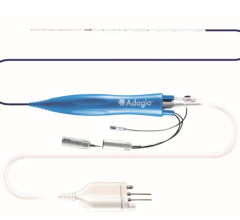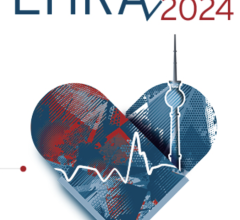
May 23, 2023 — Sacubitril/valsartan leads to greater reduction in plasma NT-proBNP levels compared to valsartan alone after stabilization for worsening heart failure in patients with an ejection fraction (EF) above 40%, according to late breaking science presented today at Heart Failure 2023, a scientific congress of the European Society of Cardiology (ESC),1 and published in the Journal of the American College of Cardiology.
Principal investigator Dr. Robert Mentz of Duke University Medical Center, Durham, US said: “These data add to the evidence supporting a potential treatment benefit of sacubitril/valsartan in patients with EF over 40% and particularly in those with EF below normal (<60%). The findings may influence future guidance for the use of the drug in this population, both in and out of hospital and for those with acute, chronic or de novo heart failure.”
Guidelines recommend consideration of sacubitril/valsartan to reduce hospitalizations in patients with heart failure with preserved EF (HFpEF; EF >50%) and/or mildly reduced EF (HFmrEF; EF 41-49%).2,3 Recommendations differ around the world, with some noting benefits are more evident in those with EF on the lower end of this spectrum (i.e. below normal).
The PARAGON-HF trial excluded patients with decompensated heart failure, but a post-hoc analysis suggested a larger benefit with sacubitril/valsartan in those recently hospitalized.4 Whether initiation of sacubitril/valsartan is safe and effective in patients with EF over 40% stabilized after a worsening heart failure event was unknown. In addition, further data were needed in populations excluded by PARAGON-HF (estimated glomerular filtration rate [eGFR] <30 ml/min/1.73 m2, systolic blood pressure <110 mmHg, and body mass index [BMI] >40 kg/m2).5
PARAGLIDE-HF evaluated the effect of sacubitril/valsartan versus valsartan on changes in NT-proBNP, safety and tolerability in heart failure patients with EF above 40% who had been stabilized after a worsening heart failure event.6 The primary endpoint was the time-averaged proportional change in NT-proBNP from baseline through Weeks 4 and 8. It was chosen to mirror the PIONEER-HF trial, which found that among patients with heart failure with reduced EF (<40%) who were hospitalized for acute decompensated heart failure, sacubitril/valsartan led to a greater reduction in NT-proBNP concentration than enalapril.7
Patients were recruited from 100 sites in the US and Canada. A total of 466 patients with EF above 40% were enrolled within 30 days of a worsening heart failure event (69% were enrolled while in hospital). The average age was 70 years, 52% were women and 22% were Black. Participants were randomly allocated in a 1:1 ratio to sacubitril/valsartan or valsartan. The time-averaged reduction in NT-proBNP was greater with sacubitril/valsartan compared with valsartan (ratio of change 0.85; 95% confidence interval [CI] 0.73–0.999; p=0.049).
The secondary composite hierarchical outcome consisted of a) time to cardiovascular death, b)number and timing of heart failure hospitalizations, c) number and timing of urgent heart failure visits and d) time averaged proportional change in NT-proBNP from baseline to Weeks 4 and 8. This outcome was evaluated using a win ratio analysis, which considers the clinical hierarchy and timing of each component of the endpoint. More serious events are given a higher priority and are analyzed first. The hierarchical outcome favored sacubitril/valsartan (as did each of the components) but was not significant (unmatched win ratio 1.19; 95% CI 0.93–1.52; p=0.16).
Regarding other secondary endpoints, compared with valsartan, sacubitril/valsartan reduced worsening renal function (odds ratio [OR] 0.61; 95% CI 0.40–0.93). There was more symptomatic hypotension in the sacubitril/valsartan group (OR 1.73; 95% CI 1.09–2.76). Importantly, subgroup analyses showed evidence of a larger treatment effect in those with EF ≤60% for the change in NT-proBNP (0.78; 95% CI 0.61-0.98) and the hierarchical outcome (win ratio 1.46; 95% CI, 1.09–1.95).
Dr. Mentz said: “PARAGLIDE-HF complements PARAGON-HF by focusing on patients stabilized after a worsening heart failure event with EF above 40% similar to the manner in which PIONEER-HF complemented PARADIGM-HF in patients with reduced EF.8 PARAGLIDE-HF had no run-in period, allowed both newly diagnosed heart failure and improved EF, included those with acute heart failure without specific echocardiographic requirements and overall had a diverse study population (52% women, 22% Black individuals). The trial also permitted patients with eGFR down to 20 ml/min/1.73 m2, systolic blood pressure as low as 100 mmHg, and any BMI. The broad and diverse population included in PARAGLIDE-HF supports the generalizability of these data to similar patients seen in routine practice.”
For more information: www.escardio.org
Find more ESC23 conference coverage here
References and notes
1PARAGLIDE-HF will be presented during the session ‘Late breaking clinical trials: medical therapy’ which takes place on 21 May at 11:15 CEST in Room 1.
2McDonagh TA, Metra M, Adamo M, et al. 2021 ESC Guidelines for the diagnosis and treatment of acute and chronic heart failure. Eur Heart J. 2021;42:3599–3726.
3Heidenreich PA, Bozkurt B, Aguilar D, et al. 2022 American College of Cardiology/American Heart Association/Heart Failure Society of America Guideline for the Management of Heart Failure: Executive Summary. J Card Fail. 2022;28:810–830.
4Vaduganathan M, Claggett BL, Desai AS, et al. Prior heart failure hospitalization, clinical outcomes, and response to sacubitril/valsartan compared with valsartan in HFpEF. J Am Coll Cardiol. 2020;75:245–254.
5Solomon SD, McMurray JJV, Anand IS, et al. Angiotensin-neprilysin inhibition in heart failure with preserved ejection fraction. N Engl J Med. 2019;381:1609–1620.
6Mentz RJ, Ward JH, Hernandez AF, et al. Rationale, design and baseline characteristics of the PARAGLIDE-HF trial: sacubitril/valsartan vs valsartan in HFmrEF and HFpEF with a worsening heart failure event. Card Fail. 2023;S1071-9164(23)00040-4.
7Velazquez EJ, Morrow DA, DeVore AD, et al. Angiotensin-neprilysin inhibition in acute decompensated heart failure. N Engl J Med. 2019;380:539–548.
8McMurray JJV, Packer M, Desai AS, et al. Angiotensin-neprilysin inhibition versus enalapril in heart failure. N Engl J Med. 2014;371:993–1004.


 April 10, 2024
April 10, 2024 








